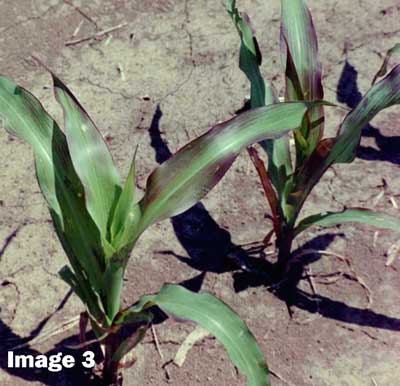- Dry soil conditions sometimes result in plant hunger symptoms that really aren't related to the fertility level of the soil.
- Wet soil conditions may also induce plant food hunger symptoms because lack of oxygen limits root function and root growth.
- Plant food is supplied to the growing plant in one of three major processes.
How Nutrients Are Supplied to Growing Plants
Nitrogen and Potassium are supplied to the growing plant via three major means: 1. Diffusion refers to movement from an area of high concentration to an area of lower concentration. (There is much more to it than this, but the definition should work for now.) 2. Root interception is an important means of supplying nutrients to the growing plant. Growing roots physically encounter nutrients attached (adsorbed) to soil particles and residing in the soil interstices and in the soil-water interface. 3. Nitrogen and Potassium move primarily through "mass flow." As plants absorb and transpire water, soluble nutrients physically move with the water into the root interface zone.
Impact of Dry Soil Conditions
Under truly dry soil conditions both root interception and mass flow of nutrients are interrupted. Root growth slows, so roots fail to encounter the needed nutrients in the soil. Also, the lack of free soil moisture interferes with the normal mass flow process. This means that certain nutrients can be temporarily in short supply to the growing plant, even though adequate amounts are present in the soil. It is common to observe potassium and nitrogen deficiency symptoms in corn that is experiencing drought conditions.
Impact of Wet Soil Conditions
Ironically, wet soils can limit nutrient uptake into crop plants. This is because soils lose oxygen soon after becoming saturated. Roots cannot function normally in the absence of soil oxygen. So, even though soil nutrients may be at adequate levels in the soil, the roots are unable to take up and transfer the nutrients into the plant. In addition, wet soils can cause leaching of mobile nutrients to where the roots cannot take up these nutrients. Also, under wet soil conditions, nitrogen in the nitrate form may be converted to gaseous forms and lost to the crop system.
Phosphorous Supply to Plants
What about phosphorous? Phosphorous is tightly held to soil particles and is only minimally available through mass flow. Under drought conditions, phosphorous can be in short supply to the plant, but phosphorous is, otherwise, generally well distributed in the soil and available to plant roots. Phosphorous is generally available through root interception. Anything that interferes with growth of root hairs, or damages root hairs, can result in the appearance of phosphorous deficiency symptoms in the plant.


Image 1: Nitrogen pattern deficiency in corn on wet soil
Image 2: Potassium deficiency syptoms in soybeans, image by John Grandin
Image 3: Root inhibitors- Induced phosphorous deficiency in corn